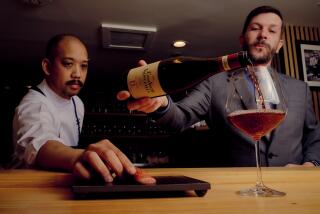When it comes to sabering a Champagne bottle, it’s not the size of your sword that counts
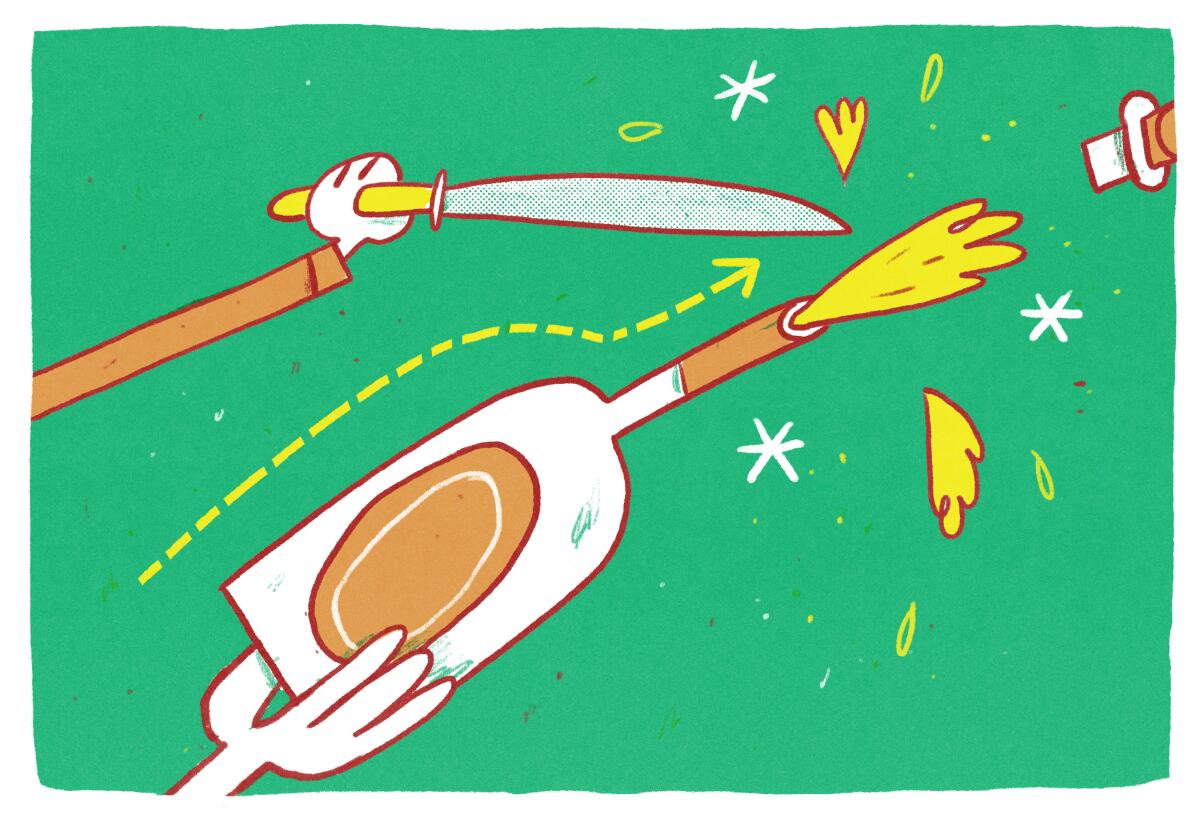
- Share via
Late one night, having consumed the exact quantity of wine that makes this sort of thing seem like a good idea, I watched, giggling, as sommelier Ashley Santoro tried to open a bottle of sparkling wine with an iron.
I am not referring to some hip, new wine gadget, but rather, the household appliance with which one removes wrinkles from clothing. Santoro cradled the wine bottle in her left hand and grasped the handle of the iron in her right. With smooth, confident motions, she ran the side of the iron up along the contour of the wine bottle, starting at the label and ending at the cork, hoping that when the edge of the iron hit the lip of the neck, the top and cork would fly off.
Eat your way across L.A.
Get our weekly Tasting Notes newsletter for reviews, news and more.
You may occasionally receive promotional content from the Los Angeles Times.
After three failed attempts, amid the hooting and hollering of onlookers, Santoro gave up. She shrugged and yanked the cork out the old-fashioned way, with her hand.
This was an important moment for me, because it marked the beginning of my fascination with sabering (sabrage in French): the art of opening Champagne with a sword.
The origins of the practice are disputed, but most agree it was popularized in France during the Napoleonic Wars of the early 1800s. The most oft-cited story is that the French Hussars, Napoleon’s cavalrymen and noted saber-wielders, were the first to do it. Napoleon was himself a great champion of Champagne, having forged a friendship early in his life with the heir to the Moët Champagne house, Jean-Rémy, and he made frequent detours through the Champagne region on his way to battle. One legend posits that, after retaking the city of Reims from the Russians in 1814, the French Hussars celebrated their victory at the cellars of Barbe-Nicole Clicquot — the famous veuve (widow) of Veuve Clicquot. To impress the wealthy 36-year-old, the Hussars took turns sabering bottles from horseback.
If you want to upset a French person, simply mention the theory that it was another nation’s invading army — either the Prussians from Bavaria or Cossacks from the Russian Steppes — who invented sabrage.
In their book “Champagne,” authors Don and Petie Kladstrup note that in 1814, before the French retook Reims, Prussian troops broke into the cellar of Adolphe Jacquesson — another last name that will be familiar to Champagne buyers. A noted experimenter, Jacquesson had topped several of his bottles’ corks with a wire cage. (This had not yet become common practice; at the time, Champagne corks were secured with wax and string.) Annoyed by the complicated closure, the Bavarians “simply broke the necks off and guzzled what they could.”

I’m a bit of a Hussars fangirl, and thus have a slight preference for the former theory. To be more specific, I’m obsessed with Ridley Scott’s 1977 directorial debut, “The Duellists,” which stars a young Harvey Keitel and even younger Keith Carradine as Hussars in Napoleon’s army. Mustaches waxed, hair braided, hats precariously tall and tasseled, their characters duel constantly and over nothing. These seem like the type of men who would open wine with their swords.
Though it’s less shrouded in mystery, I find the science of sabering as interesting as the history. Much of it has to do with the nature of glass, an atomically disordered solid that even today manages to confound chemists and physicists. Because glass is in the vitreous, or amorphous state — it is a non-crystalline solid with molecules jumbled around like a liquid — it is intrinsically unstable. And because of its ionic molecular structure, glass is also brittle, which means that when a glass bottle is pressurized from within (hello, Champagne), all you have to do is introduce the tiniest fracture and then, boom, the crack will propagate. The chemical structure of the glass and the pressure of its contents create a near-instant cleavage.
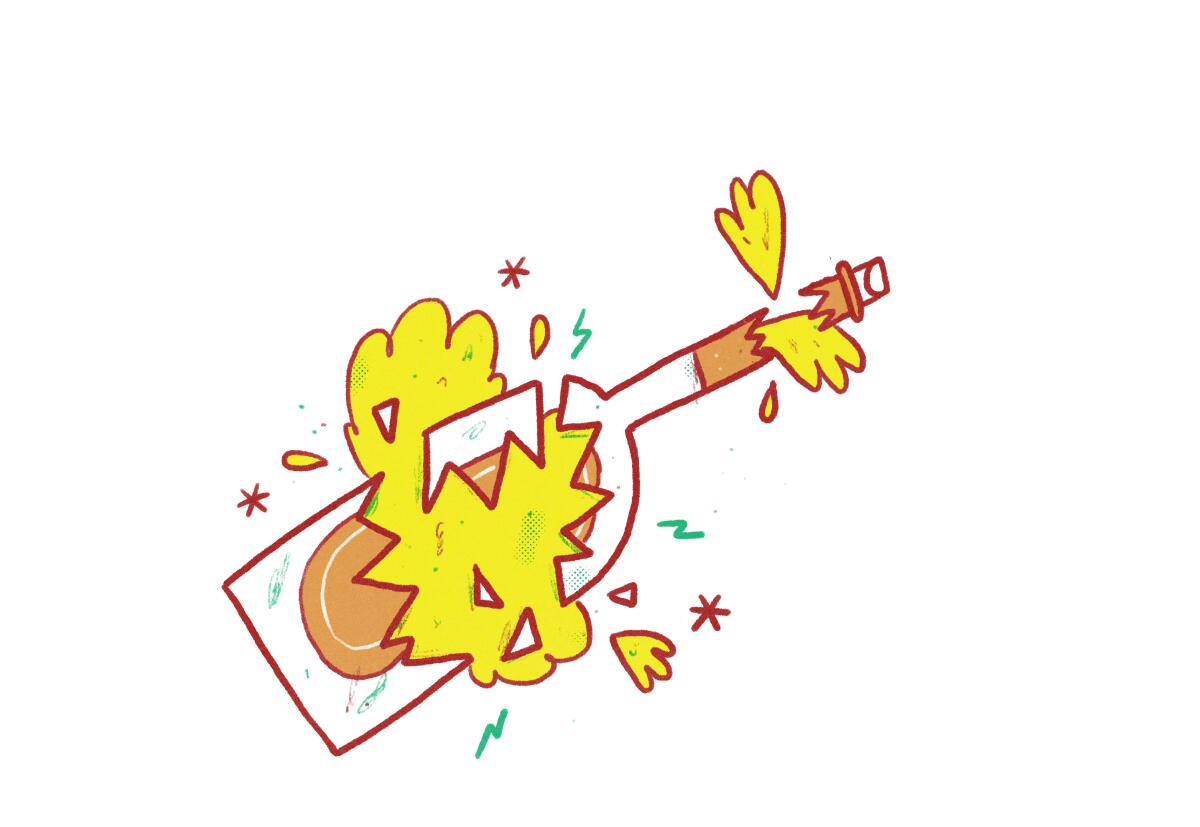
This is why you don’t actually need a sharp object to saber — in fact, it’s best to do it with the blunt rather than sharp edge of a sword or knife — and why it’s so easy to “saber” a bottle of sparkling wine with many non-sword objects.
“Give me enough Champagne and I’ll pretty much saber with anything,” says Santoro, who is now a regional beverage director for the Standard Hotels and a partner in the New York wine shop Leisir. Her favorite implements? A waiter’s friend-style wine key and a hardcover book.
Joel Burt, the winemaker at Las Jaras, says he has sabered hundreds of bottles, with objects such as a butter knife, the base of a crystal wine glass and even his old iPhone 5.
For Michael Cruse, the winemaker behind Cruse Wine Co. and the cult-favorite California sparkler Ultramarine, sabering is often the easiest, most practical option.
“I saber all the time. Mainly because I keep a Leatherman in my pocket at all times in the cellar, so pulling it out and popping open bottles is faster than finding my disgorging key.” Cruse notes that the handle of a wrench is a similarly utilitarian way to get the job done.
Both Cruse and Santoro credit the renewed popularity of sabering to Patrick Cappiello, who opened the influential, wine-centric restaurant Pearl & Ash in New York in 2013.
Pearl & Ash closed in 2016, and Cappiello is now a winemaker, importer and distributor. But Pearl & Ash’s short run belies its influence: It was the inspiration for many of the punky, small-plates, wine-forward restaurants that flourish today.
Cappiello’s introduction to sabering came at Veritas, a fine-dining restaurant enshrined for all time through its inclusion in Anthony Bourdain’s “Kitchen Confidential,” where he worked as a sommelier in the 2000s. There, he remembers a client who stored a saber on premises. The client would periodically pop in, ask the staff to retrieve his sword from the back and use it to open Champagne.
“In the early days of Pearl & Ash, there was always something to celebrate, like our two-star review in the New York Times,” Cappiello remembers. Standing on the bar and sabering Champagne seemed to him like an appropriately festive way to mark the occasion. Word of Cappiello’s theatrics spread, and eventually, guests were wandering in on random weekdays, ordering Champagne and asking him to saber open the bottles.
These were the early days of “food Instagram,” and it’s no surprise that Cappiello and sabering went viral. Here was spirit of the Hussars, reborn and repackaged into one-second Boomerangs.
Bradford Taylor, a partner in the Silver Lake natural-wine shop Psychic Wines and owner of the wine bar Ordinaire in Oakland, commemorated Ordinaire’s first anniversary in 2014 with neon pink “Sabertime!” T-shirts, featuring a bottle of Champagne encircled by an array of sabering implements: machete, chef’s knife, serrated knife, butter knife, cleaver. But he and his staff have backed off sabering in recent years, he says. “It started to feel more and more like a hypermasculine display of power.”
“Once people saw Patrick doing it, other somms started breaking out these giant knives and swords and it kind of became a contest of who had the biggest sword,” Santoro said, laughing.
It is perhaps unsurprising that something invented by drunk, swaggering French military men on horses became popular with today’s dude-bro sommelier set. (Cappiello doesn’t fall in that camp — for him, sabering was more a commentary on the formality and rigidity of old-school somm culture — and the first thing he said during our interview was, “I’m tired of being the saber guy.”)
Nevertheless, in the comfort of my own home, I remain unapologetically pro-saber.
To me, sabering is a reminder that wine doesn’t have to be uptight, stuffy or precious. Wine — especially sparkling wine — is a joy, and sabering is an easy way to bring even more fun and levity to the proceedings. This New Year’s Eve, I’ll be in my backyard, sparkling wine and sword — or maybe knife, or wrench or book? — in hand, ready to ring in the new decade the way I like to imagine a young Harvey Keitel would have done it.
How to saber a bottle
Before we begin, some caveats, as sabering can be dangerous:

- If you’re too tipsy to drive, you’re too tipsy to saber.
- Never saber in a crowded area. Find a safe, ideally outdoor area and aim the cork away from friends, pets and fragile objects. If you’re successful, the top will go flying as far as 40 feet. It is a dangerous projectile!
- NEVER drink straight from a sabered bottle, and don’t place a sabered bottle back in an ice bucket or cooler, lest someone reach in and cut themselves. The top of the sabered bottle will break off cleanly — that’s what all that pressure in the bottle helps with — but sharp, broken glass is sharp broken glass, and should be regarded respectfully.
Step 1: Pick a suitable wine to saber. It has to be sparkling — it’s the pent-up energy inside the bottle that makes the whole thing work. You’ll have better luck with Champagne or a méthode traditionnelle wine than something only lightly frizzante. The bottle can have either a beer-style crown cap or the more traditional cork and cage, so long as there’s a lip, or “annulus.”
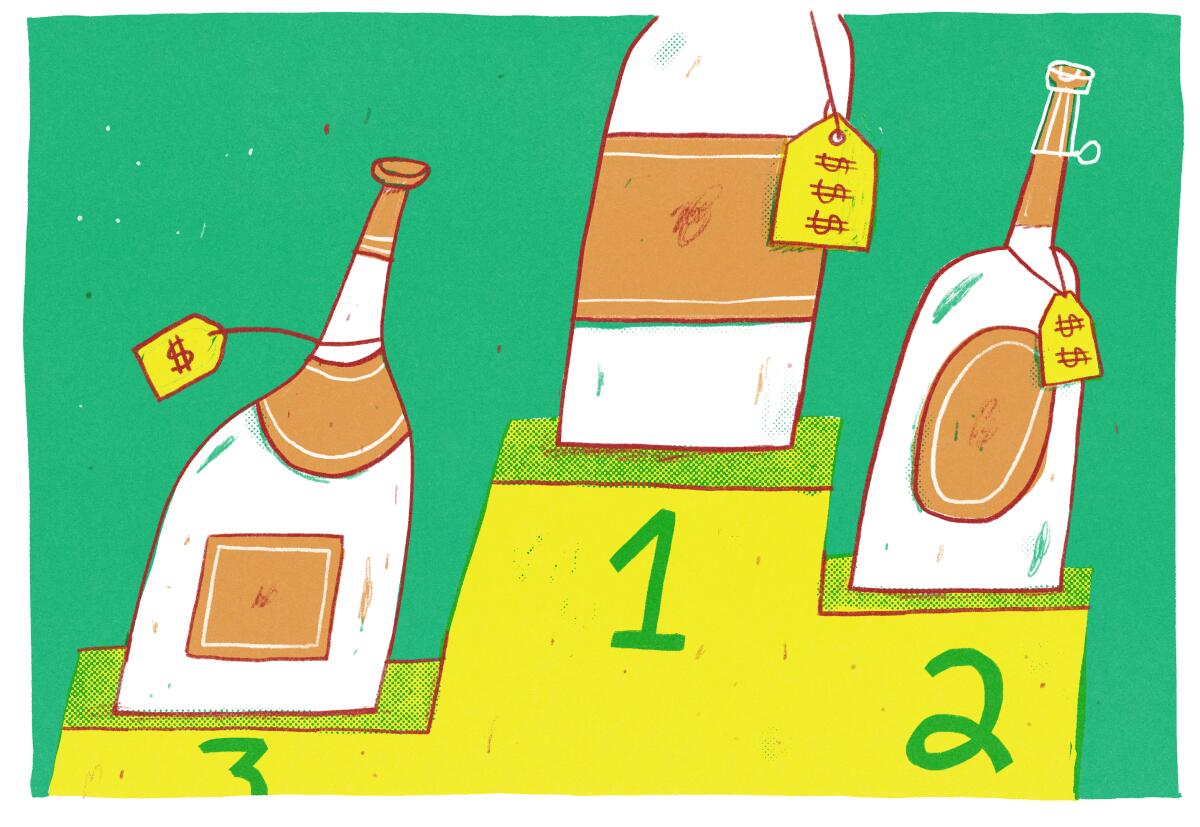
Step 2: Choose your sabering implement. The blunt edge of a chef’s knife is a great place to start.
Step 3: Chill your wine so it’s really cold; 37 degrees Fahrenheit is ideal. Leave it in the fridge for several hours or in an ice bath for at least 25 minutes. If you’re using an ice bath, make sure to chill it upside-down for a bit, so the neck gets super cold. (When you see a “saber fail” — i.e., the neck never breaks or the bottle totally shatters — most of the time it’s because the bottle is too warm.) Despite what you may have seen during sports postgame parties, do not shake the bottle.
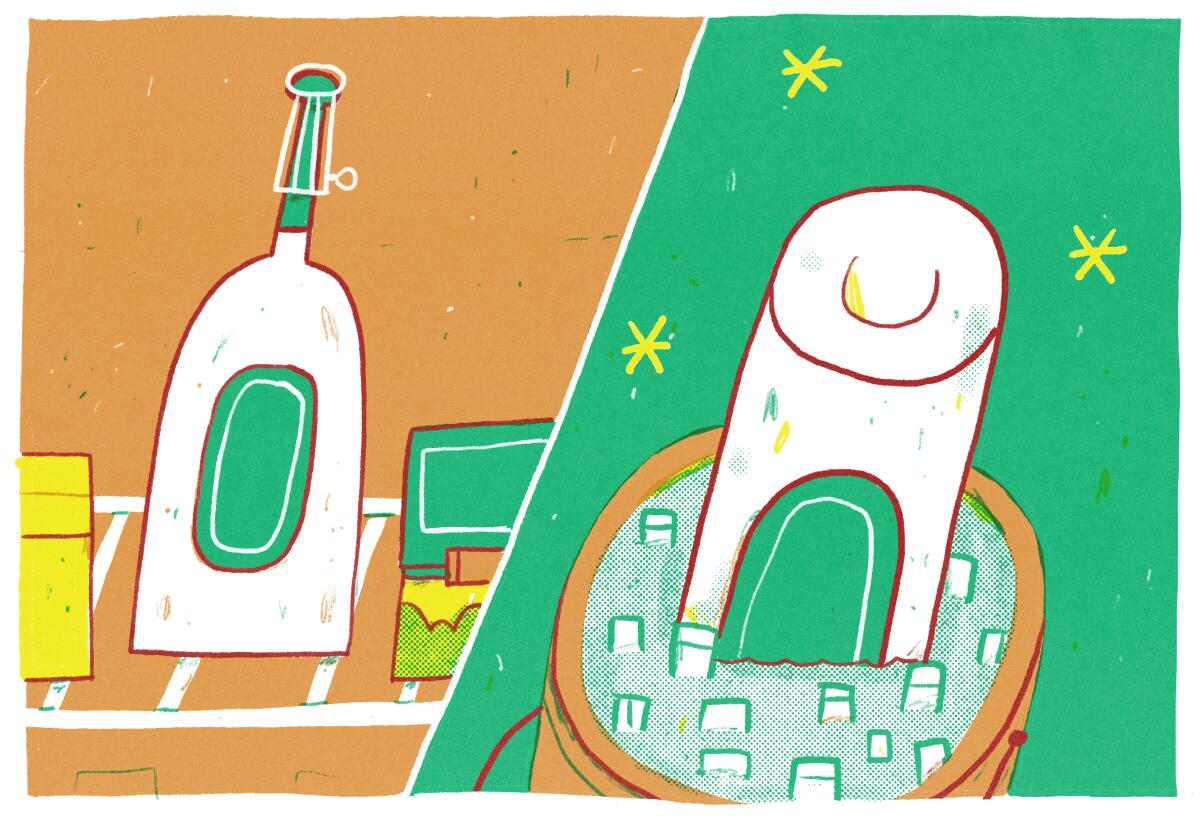
Step 4: If the bottle has foil or a cage over the cork, remove both. Hold the bottle with your non-dominant hand. If the bottle has a “punt” (the indented dimple on the bottom of the bottle), stick your thumb in the punt and cradle the bottle on top of your other four fingers.
Step 5: Every wine bottle has a “seam” running the length of the bottle. Find the seam of the bottle and make sure it is facing up. This is your runway for the saber.
Step 6: It’s saber time! The most important thing to remember is that sabering is not about force, it’s about finesse. If you whack at the bottle or try to chop off the top, you’re guaranteed a saber fail. It’s not about strength or the sharpness of your tool; thanks to physics, you can literally do it with a butter knife. Rest your saber at the top of the label, on the seam, at a 30- to 45-degree angle. With one smooth, confident motion, run the saber up the neck along the seam toward the cork. The point where the seam connects with the annulus is structurally the weakest part of the bottle. When the saber hits that point, the top should fly off. The warmer the wine, the more you may lose to overflow, so have your glasses ready. Rejoice.
Wines to saber
Champagne is, of course, the traditional choice. For Philippe Milgrom, an ambassador of the U.S. chapter of the Confrérie du Sabre d’Or, a sabering enthusiasts’ club founded 33 years ago in France that claims to have more than 35,000 members worldwide, Champagne is the only choice. “We recently expelled one of our ambassadors because there was a photo of her sabering sparkling wine — not Champagne — on her website.”
With respect to M. Milgrom, the origin of the wine is less important than the amount of pressure in the bottle (at least 4 bars, though not every wine shop will be able to tell you that offhand).
Here are a few California wines that fit the bill:
- Cruse Wine Co., St. Laurent Pétillant Naturel, 2018
- Martha Stouman, Sparkling Zinfandel, 2017
- Broc Cellars, Mendocino Valdiguié Pétillant, 2018
- Las Jaras, Sparkling Wine, 2017
- Blue Ox, Mutiny on the Bounty Sparkling Nouveau, 2019
More to Read
Eat your way across L.A.
Get our weekly Tasting Notes newsletter for reviews, news and more.
You may occasionally receive promotional content from the Los Angeles Times.


